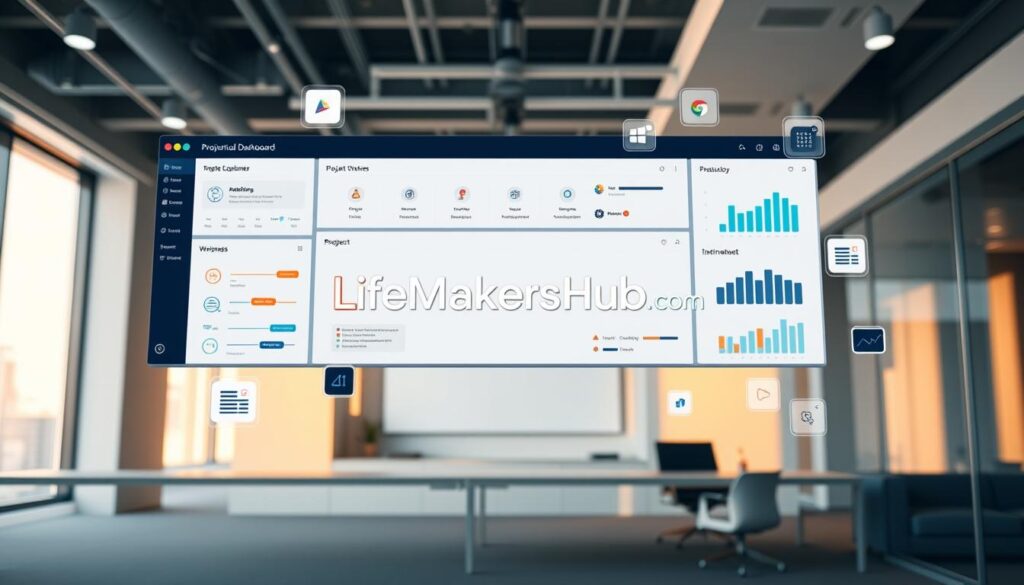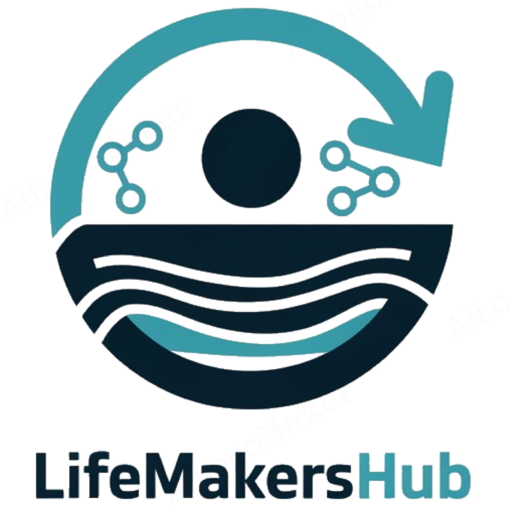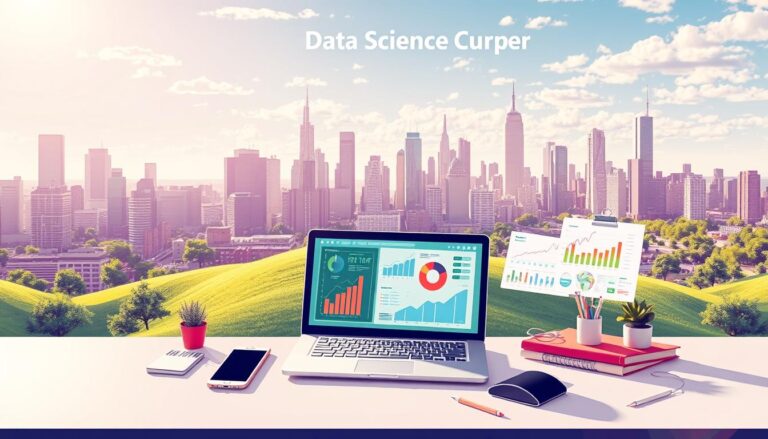AI-Powered Productivity & Project Management: Enhance Your Workflow
In today’s fast-paced world, staying ahead requires smarter ways to handle tasks. Artificial intelligence is transforming how we approach project management, making workflows more efficient and effective. Rather than replacing roles, it empowers professionals to focus on strategic work by automating repetitive tasks1.
Streamlined automation, real-time insights, and risk mitigation are just a few benefits of integrating these advanced tools into your workflow. For example, AI can analyze large datasets to uncover patterns, aiding in better decision-making2. This allows teams to work smarter, not harder.
In this article, we’ll explore how these innovations can elevate your productivity and provide a detailed roundup of the best solutions available. Whether you’re managing a small project or leading a large team, these insights will help you optimize your approach.
Key Takeaways
- AI enhances workflows by automating repetitive tasks.
- Real-time insights improve decision-making in project management.
- Risk mitigation becomes proactive with AI-driven analytics.
- Advanced tools integrate seamlessly into existing systems.
- Focus shifts to strategic work, boosting overall productivity.
Introduction to AI-Powered Productivity & Project Management
Modern workplaces demand smarter solutions to keep up with evolving challenges. Integrating advanced technologies into everyday operations is no longer a luxury—it’s a necessity. These innovations are reshaping how professionals handle tasks, making workflows more efficient and effective3.
Setting the Stage for AI Integration
Adopting these technologies starts with understanding their potential. Automation can handle repetitive tasks, freeing up time for strategic work. Enhanced scheduling ensures deadlines are met, while improved task assignments keep teams aligned4.
Choosing the right management tool is crucial. It should meet specific needs, whether it’s for a small project or a large team. The right solution can streamline operations and boost overall efficiency.
Why Project Managers Need AI
These technologies offer significant benefits. Cost savings and risk mitigation are just the beginning. Real-time insights improve decision-making, while predictive analytics help anticipate challenges3.
However, integration isn’t without challenges. High costs, technological limitations, and resistance to change can pose hurdles. Strategic planning and clear communication are key to overcoming these obstacles4.
By embracing these innovations, professionals can focus on what truly matters—delivering results and driving success.
Understanding the Benefits of AI in Project Management

Efficiency in handling complex tasks is now achievable with advanced technologies. These innovations are transforming how teams approach their work, making processes smoother and more effective. Let’s explore the key advantages of integrating these systems into your workflow.
Streamlined Automation and Cost Savings
One of the most significant benefits is the automation of repetitive tasks. This allows teams to focus on strategic assignments, boosting overall efficiency. For example, scheduling and reporting can now be handled seamlessly, saving valuable time5.
Cost savings are another major advantage. By tracking spending in real-time, these systems help identify areas where budgets are exceeded. This ensures better financial control and resource allocation5.
Real-Time Insights and Risk Mitigation
Access to real-time data is a game-changer. These systems analyze vast amounts of information to provide actionable insights. This helps teams make informed decisions quickly6.
Risk mitigation is also enhanced. Predictive analytics identify potential bottlenecks before they escalate. This proactive approach ensures smoother project execution5.
“The ability to predict risks and optimize resources is transforming how we manage projects.”
| Benefit | Impact |
|---|---|
| Automation | Reduces manual effort, saves time |
| Cost Savings | Improves budget management |
| Real-Time Insights | Enhances decision-making |
| Risk Mitigation | Prevents delays and bottlenecks |
By leveraging these features, teams can achieve higher productivity and better outcomes. The integration of these systems is no longer optional—it’s essential for staying competitive.
AI tools for productivity and project management
https://www.youtube.com/watch?v=oYbmminUGVo
Choosing the right technology can make or break your workflow efficiency. With so many options available, it’s essential to focus on the features that align with your team’s needs. A well-selected system can streamline tasks, improve collaboration, and boost overall results7.
Selecting the Right Features
Start by identifying your team’s pain points. Does your workflow require advanced scheduling or task automation? Look for systems that offer these capabilities. For example, tools like Motion optimize schedules using user history, saving valuable time8.
Consider scalability. A system that grows with your team ensures long-term value. Features like real-time insights and predictive analytics can also enhance decision-making7.
Evaluating User Experience and Usability
A user-friendly interface is crucial for seamless integration. Tools like Notion and ClickUp are praised for their intuitive designs, making them easy to adopt9.
Test the software before committing. Many platforms offer free trials, allowing you to assess usability and compatibility. This step ensures the system fits your team’s workflow without disruptions8.
| Feature | Benefit |
|---|---|
| Automation | Reduces manual effort, saves time |
| Real-Time Insights | Improves decision-making |
| User-Friendly Interface | Enhances adoption and usability |
| Scalability | Ensures long-term value |
Balancing cost with capability is also important. While some systems may seem expensive, their advanced features often justify the investment. For example, tools like Asana offer robust risk management features, making them worth the price9.
By carefully evaluating these factors, you can select a system that enhances your team’s efficiency and aligns with your goals.
Top AI Tools for Project & Resource Management

Effective resource allocation is crucial for successful outcomes in any professional setting. With the right platforms, teams can streamline workflows, enhance collaboration, and achieve better results. Let’s explore three top-rated solutions: Forecast, ClickUp, and Fellow.
Highlights from Forecast, ClickUp, and Fellow
Forecast excels in comprehensive project tracking and forecasting accuracy. Its advanced analytics provide real-time insights, helping teams make informed decisions10. This platform is ideal for professionals who need precise resource allocation and risk mitigation.
ClickUp stands out for its versatility and customization capabilities. It offers a wide range of features, from task assignments to budget management. Users appreciate its intuitive interface, which simplifies complex workflows11.
Fellow focuses on meeting automation and collaboration. It streamlines agendas, notes, and follow-ups, ensuring productive discussions. This platform is perfect for teams that prioritize efficient communication10.
User Reviews and Performance Ratings
User feedback highlights the strengths of these platforms. Forecast has a rating of 4.2, praised for its forecasting accuracy10. ClickUp scores 4.7, with users commending its customization options11. Fellow also earns a 4.7 rating, celebrated for its meeting automation features10.
| Platform | Key Feature | User Rating |
|---|---|---|
| Forecast | Forecasting Accuracy | 4.2 |
| ClickUp | Customization | 4.7 |
| Fellow | Meeting Automation | 4.7 |
These platforms seamlessly integrate into existing workflows, enhancing efficiency and collaboration. Whether you’re managing resources or coordinating tasks, these solutions offer the features you need to succeed.
Exploring AI for Task Management and Scheduling

Efficiently managing daily responsibilities has never been easier with the right software. By leveraging advanced systems, professionals can streamline their workflows and focus on what truly matters. Let’s dive into how specific platforms are transforming the way we handle tasks and schedules.
Streamlining Tasks with Taskade and Timely
Taskade stands out for its ability to simplify task tracking and scheduling. Its intuitive interface allows users to organize assignments effortlessly. Real-time collaboration features ensure teams stay aligned, while AI-powered insights help prioritize tasks based on urgency12.
Timely takes a different approach by focusing on time tracking. It automatically records hours spent on tasks, providing detailed reports. This helps teams identify inefficiencies and allocate resources more effectively13.
Optimizing Calendars with Clockwise
Clockwise excels in calendar management. It automatically adjusts schedules to reduce meeting conflicts and maximize focus time. By analyzing user habits, it creates optimized plans that enhance productivity12.
For example, Clockwise can reschedule meetings to free up blocks of uninterrupted work time. This proactive approach ensures deadlines are met without unnecessary stress13.
These platforms not only save time but also improve overall efficiency. By automating repetitive tasks, they allow professionals to focus on strategic work. Whether you’re managing a small team or a large project, these tools can make a significant difference.
Innovative AI Solutions for Collaborative Workflows
Collaboration is the backbone of successful workflows, and innovative solutions are transforming how teams connect and share resources. By leveraging advanced features, professionals can enhance communication, streamline document sharing, and foster a more cohesive work environment.
Enhancing Team Communication
Effective communication is essential for any team. Platforms like Slack and Microsoft Teams integrate seamlessly with other tools, enabling real-time updates and reducing missed messages. For example, 85% of teams using these platforms report improved project outcomes14.
AI-driven chatbots can handle routine queries, freeing up time for strategic discussions. This not only boosts efficiency but also ensures that every team member stays informed15.
“Real-time communication tools have revolutionized how we collaborate, making it easier to stay aligned and productive.”
Improving Document and Resource Sharing
Sharing documents and resources has never been easier. Platforms like Google Drive and Dropbox offer cloud-based storage, ensuring that files are accessible from anywhere. This eliminates the hassle of email attachments and version control issues16.
Advanced features like automated tagging and search functionality make it simple to locate specific files. For instance, teams using these systems save up to 40% of the time spent on manual searches14.
| Platform | Key Feature | Benefit |
|---|---|---|
| Slack | Real-Time Messaging | Improves team alignment |
| Google Drive | Cloud Storage | Enhances accessibility |
| Dropbox | Automated Tagging | Simplifies file searches |
By adopting these solutions, teams can focus on what truly matters—delivering results. Whether you’re managing a small group or a large organization, these tools can make a significant difference in your workflow.
Integrating AI with Existing Project Management Platforms

Adopting advanced technologies into your workflow doesn’t have to be overwhelming. With the right approach, you can seamlessly integrate these systems into your current setup, enhancing efficiency without disrupting operations. Let’s explore how to make this transition smooth and effective.
Seamless Integrations and Customizations
One of the key benefits of these systems is their ability to integrate with existing platforms. For example, 74% of businesses found that using advanced communication tools significantly improved the accuracy and timeliness of updates17. This ensures that your team stays aligned without needing to switch between multiple applications.
Customization is another critical factor. Tailoring the system to match your team’s workflow can maximize its potential. Features like automated scheduling and real-time tracking can be adjusted to meet specific needs, ensuring a seamless experience18.
Overcoming Setup and Transition Challenges
While the benefits are clear, the transition process can present challenges. Resistance to change and technical limitations are common hurdles. However, with proper planning and support, these can be mitigated. For instance, companies using advanced scheduling tools saw a 15-20% reduction in delays17.
Clear communication and training are essential. Providing team members with the resources they need to adapt ensures a low-friction onboarding process. This not only reduces disruptions but also boosts overall confidence in the new system18.
“The key to successful integration lies in understanding your team’s needs and addressing potential challenges proactively.”
| Benefit | Impact |
|---|---|
| Seamless Integration | Reduces disruptions, enhances alignment |
| Customization | Tailors system to specific workflows |
| Improved Scheduling | Reduces delays by 15-20% |
| Training and Support | Ensures smooth onboarding |
By focusing on these strategies, you can integrate advanced systems into your workflow with confidence. The result? A more efficient, cohesive, and productive team.
Real-World Impact of AI on Daily Project Management
The transformative power of advanced systems is reshaping how professionals approach their daily routines. From improved forecasting to streamlined task assignments, these innovations are making a tangible difference. Let’s explore how they’re changing the game through real-world examples and feedback from US-based professionals.
Case Studies and Success Stories
One tech company reduced testing time by 40% using intelligent systems, allowing their team to focus on higher-value activities19. Another example is a retail company that adapted its marketing strategies in real-time, resulting in increased sales and customer engagement19.
These success stories highlight the efficiency gains and cost savings achieved through smart solutions. By automating repetitive tasks, teams can allocate more time to strategic work, enhancing overall outcomes20.
Feedback from US-Based Project Managers
US-based professionals are seeing significant benefits. For instance, one manager noted, “The ability to predict risks and adjust timelines has been a game-changer for our team.” This proactive approach ensures smoother operations and better results20.
Another manager shared how advanced systems improved their planning process. “We’ve been able to allocate resources more effectively, reducing delays and increasing profitability,” they said21.
“The integration of these systems has not only saved us time but also improved our decision-making process.”
These insights demonstrate the real-world impact of adopting modern solutions. By leveraging data-driven insights, professionals can enhance their workflows and achieve better outcomes. Whether it’s through improved scheduling or risk mitigation, the benefits are clear.
Conclusion
Embracing advanced systems can revolutionize how you handle daily tasks. From automating repetitive processes to providing real-time insights, these solutions enhance efficiency and streamline workflows. Studies show that integrating such systems can improve task throughput by up to 35%, making them invaluable for any project22.
Real-world examples highlight the transformative impact. Teams using these systems report faster task completion and better resource allocation. For instance, customer support agents saw a 13.8% increase in inquiries handled per hour22. These results demonstrate the tangible benefits of adopting modern solutions.
As you plan for the coming month, consider experimenting with these innovations. Whether you’re managing a small project or leading a large team, the right tool can make a significant difference. Start small, evaluate the impact, and scale as needed.
By integrating these systems into your workflow, you’ll not only save time but also improve decision-making. The future of project management is here—take the first step today and experience the benefits firsthand.
FAQ
How does AI improve project management workflows?
What features should I look for in an AI-powered management tool?
Can AI tools integrate with existing platforms?
How does AI help with task scheduling and resource allocation?
Are AI tools suitable for small teams or startups?
What are the risks of using AI in project management?
How do AI tools enhance team collaboration?
What are some top-rated AI tools for project management?
Source Links
- 23 AI Productivity Tools to Revolutionize Your Workflow | DigitalOcean
- Top 10 AI Project Management Tools to Improve Performance
- AI for Project Management: Tools and Best Practices | The Workstream
- ChatGPT and AI-Powered Project Management – Revolutionize your Project
- Using AI in Project Management: Key Tools and Benefits | Sembly
- The Power of AI in Project Management Tools
- We Tested 50+ AI Productivity Tools. Here Are The 16 Best Tools in 2025
- 24 AI Tools for Work to Increase Productivity
- The 6 Best AI Project Management Tools to Help You Succeed
- The 10 Best AI Project Management Tools in 2025 by Forecast
- I Tried 10 AI Project Management Tools to See if They’re Worth It (Results & Recommendations)
- Boosting Productivity with AI-Powered Task Management
- AI Task Manager: I Tested 20+ Task Managers. Here’s My Top 7
- How AI Empowers Collaboration Tools for Project Management
- The Best AI Productivity Tools in 2025 | Webex
- 6 ways to use AI in collaborative tools for smarter project management | Klaxoon
- Integrating AI with Project Management
- Top 10 Ways AI Transforming Project Management in 2025
- AI Meets Agile: Transforming Project Management For The Future
- How Is AI Impacting Project Management? Humans Still Needed
- AI’s Real-World Impact on Project Management: Industry Insights
- AI Improves Employee Productivity by 66%







